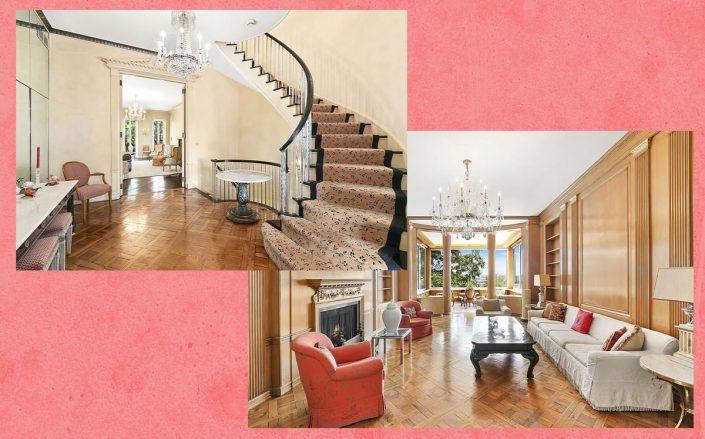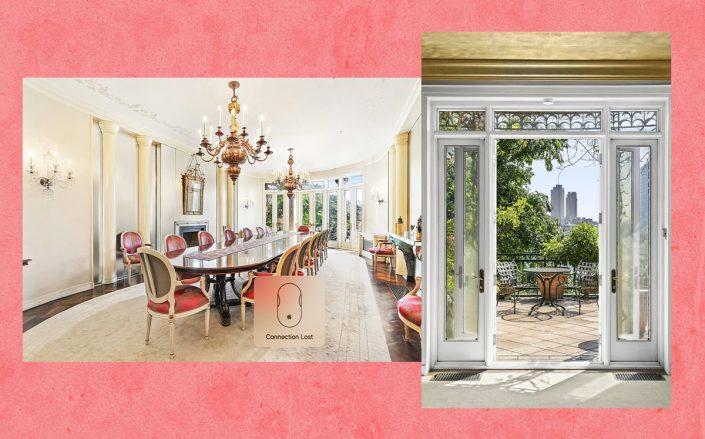Controlling an estimated $700 million fortune, Princess Ashraf Pahlavi fled Iran in 1978, less than a year before the fall of her twin brother the shah. The princess, who many considered the brains behind her brother’s power, spent the rest of her long life in lavish exile, with luxury properties in the United States and France.
More than 40 years after the Iranian Revolution forced her out and four years after her death, a battle is intensifying over the sale of the princess’ 12,000-square-foot Midtown mansion. It is a feud that has pitted two of her former employees against each other — revealing an inventory of the princess’ riches in the process — and continues to rage as the townhouse’s market price plummets.
The eight-story building at 29 Beekman Place — whose amenities include a wine cellar, a banquet hall and eight wood-burning fireplaces — is a few blocks from the United Nations, where the princess worked on behalf of women’s causes. CBS titan William S. Paley built the property in 1934 for his wife, Dorothy. It became the princess’ home after her brother, Shah Mohammed Reza Pahlavi, was deposed. She still owned it when she died in 2016 at age 96.
Despite its prime location and storied history, attempts to sell the townhouse have been complicated by the yearslong dispute between Gholam Reza Golsorkhi, whom the princess hired in 1970 to manage her affairs, and Azadeh Nasser Azari, whom Golsorkhi hired in 1979 as a secretary. Azari eventually rose to a key position within the entity created to oversee the princess’ assets, Wansdown Properties Corporation.

29 Beekman Place (Courtesy of Zillow)
The fight over the mansion has included several court decisions and prompted Wansdown’s bankruptcy filing, which Azari claims was intended to prevent her from getting long-promised millions from the estate. It has even pulled the princess’ grandson into the mix.
The mansion returned to the market in early May, asking just under $11.5 million, a bargain compared with its initial $50 million listing in 2014. The price was also chopped in 2017, to $28 million, and at least two recent potential sales have fallen apart — one of which is still tied up in the courts. Compass broker Charlie Attias and a Rosewood Realty team led by Greg Corbin is handling the current listing.
The listing has attracted interest, according to sources with knowledge of the property, even as the coronavirus continues to decimate the Manhattan luxury market and despite buyers’ general aversion to properties with complex legal entanglements, industry experts said.
Real estate attorney Ed Mermelstein said properties like this one tend to attract buyers that he described as “bottom feeders.” They are “looking to get a great deal, so they make very lowball offers,” he said. “Unfortunately, you need a seller who’s in a position to sell at that price, which typically is not the case.”
After the revolution
Princess Pahlavi lived a famously controversial life, playing a key role in the 1953 overthrow of Iranian Prime Minister Mohammad Mosaddegh and surviving a 1977 assassination attempt. Andy Warhol even painted her portrait in 1978.
After Pahlavi fled Iran, Golsorkhi continued to work for her as managing director of Wansdown. Formed in 1979 to invest and manage the princess’ assets, the company is still listed as the owner of 29 Beekman.
Golsorkhi and the princess soon hired Azari, partly because she refused to pledge allegiance to the ayatollah after the revolution. She previously worked at the Consulate General of Iran in New York.
Azari started at Wansdown as an executive assistant but ultimately became the firm’s office manager, according to a 2016 affidavit from Golsorkhi.
“In consideration for her loyalty, competence and diligence,” the princess assured Azari that she would take care of her financially going forward, Golsorkhi wrote. He also wrote that he made similar assurances, promising that Wansdown “would pay her monthly salary for the remainder of her life.”
The affidavit supported providing Azari with a $2.7 million pension or $9,000 per month for life, and Azari filed it in New York State Supreme Court in February 2016, soon after Pahlavi’s death. The court officially docketed the affidavit as a judgment that April, confirming that Azari was entitled to her $2.7 million.
But Azari has yet to receive any money, and Golsorkhi and Wansdown have since tried to reverse the judgment multiple times.
In February 2017, Wansdown tried to vacate the judge’s decision by claiming that Golsorkhi did not have the authority to sign his affidavit and did not understand English well enough to comprehend its terms, according to court papers.
But Azari’s attorney called that an “absurd lie” that was “flatly contradicted by Golsorkhi’s own online profile.” In court documents, the attorney, Nader Mobargha, called Golsorkhi “a sophisticated individual, fluent in English,” who was educated in the United Kingdom and the United States and had a master’s degree in business.

Dorothy Hart Hirshon and William Paley (Getty)
Mobargha declined to comment for this article. Wansdown’s attorneys, Paul Rubin and Hanh Huynh, did not respond to requests for comment.
A New York appeals court ruled in October 2018 that the initial judgment in favor of Azari was valid, and a sheriff’s sale of 29 Beekman was set for the following October, to ensure she would receive her money.
But shortly before the sheriff’s sale was scheduled to happen, the princess’ grandson stepped into the fray. On Oct. 1, Kamran Abbas-Vahid filed another attempt to toss Azari’s initial judgment, accusing her of “fraud and collusion” and seeking a temporary restraining order to halt the sheriff’s sale, according to court documents. A judge quickly dismissed that motion, and on Oct. 8, just one day before 29 Beekman was due to hit the market in its sheriff’s sale, Golsorkhi and Wansdown pivoted to another strategy: bankruptcy.
Golsorkhi wrote in court papers that filing for bankruptcy would let Wansdown sell the house “in an organized sale process, and not a fire sale.” The filing includes Azari in a list of creditors but sliced her claim to just $150,000, which it notes is disputed. That amount was likely a reference to an additional bequest Azari claimed she was supposed to receive upon the princess’ death, from the Liechtenstein-based foundation Pelmadulla Stiftung.
Mobargha strongly objected to the bankruptcy, describing it in court papers as “nothing more than a selection of a new venue for [Wansdown’s] latest effort to avoid paying Ms. Azari’s three and one half year old judgment.”
Two failed sales
Wansdown went into contract to sell the house to an anonymous buyer for $10.3 million shortly before it filed for bankruptcy, and the firm said the sale would generate enough money to pay Azari’s claim in full. Azari still objected, arguing that Golsorkhi was refusing to disclose information about the buyer’s representative and had not allowed other bidders to see the townhouse.
A bankruptcy judge approved the sale in January, but it never went through. The broken deal is now the subject of competing lawsuits. Wansdown is suing the buyer for breach of contract over its failure to pay for the home, and the buyer is suing Wansdown and Golsorkhi to retrieve its roughly $1 million down payment. The buyer’s suit also claims it was only willing to purchase 29 Beekman as a favor for Golsorkhi, who was in a “desperate situation” and “pleading” with a mutual friend to prevent the mansion from being sold at a sheriff’s sale.
It marked at least the second failed sale of the townhouse. In 2017, Wansdown went into contract to sell the property for $17 million to Secured Capital Partners. But Wansdown canceled the deal after Secured Capital failed to make any of the required down payments, and last spring, the New York State Supreme Court dismissed Secured Capital’s lawsuit over the botched deal, according to a January affidavit from Golsorkhi.

29 Beekman Place (Courtesy of Zillow)
Before the company went bankrupt, Secured Capital owned a 157-acre land parcel known as the Mountain of Beverly Hills, which hit the market in 2018 for $1 billion but ended up getting sold back to its lender last August for $100,000 at a foreclosure auction.
Jewels and real estate
Underpinning Azari’s legal actions is her claim that the princess’ estate has plenty of money, but its beneficiaries are just choosing to spend it on themselves instead of paying her what she is owed.
She has specifically pointed to Pelmadulla Stiftung, which was established for the benefit of the princess’ beneficiaries and is the owner of Wansdown, according to court papers. It had up to $5.6 million in cash when the princess died and held much of her assets, including jewelry worth tens of millions of dollars and real estate holdings in France, California, Colorado, New York and St. Maarten in the Caribbean, court papers say.
“It is unclear what Pelmadulla and the Board have done with all of the Princess’ cash, assets, and investments,” her attorney wrote in court papers.
All this upheaval has made selling a substantial piece of real estate like 29 Beekman Place far more difficult, even if the pandemic hadn’t hammered the luxury market. But real estate attorney Petro Zinkovetsky said conflicts like these are not so uncommon in the world of ultra-luxury homes.
“Properties that have these issues, they have to be sold and usually are sold at a discount,” he said. “But they’re very, very problematic to sell.”
